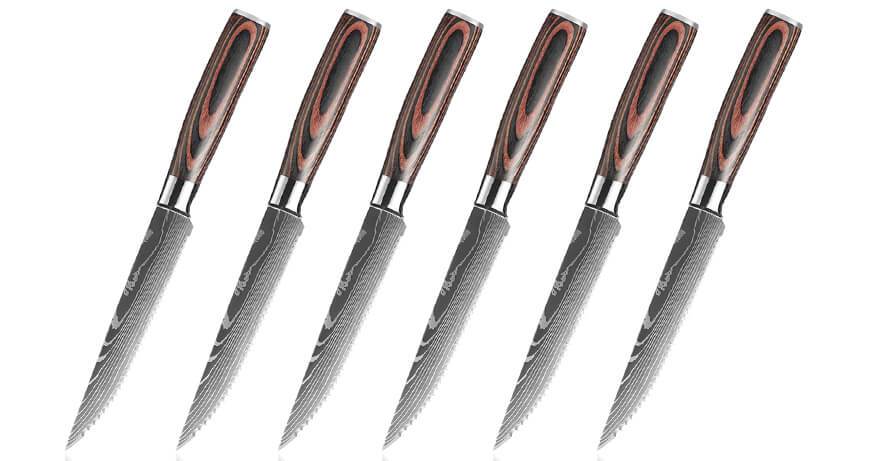The most important knives we use in our kitchen is a serrated knife much like a bread knife, a steak knife or a slicer and it seems that many people have problems with how to get this particular knife back to a sharp usable functionality in the kitchen.
So today I decided to share an article on how to sharpen a serrated blade.
1. Bristle bronze wheel
So here we are talking about serrated knives as I stated the best way is with a medium bristle bronze wheel.
The bronze itself is softer than the steel of the knife and those fine bristles work themselves into the scallops of the serrated knife to unfold the edge back to straight, and then you would take the knife and on the reverse along with that bronze wheel too to make it straight and then you would do some hand finishing.
That's the best way I've ever seen to maintaining a serrated knife. Now there are a lot of gadgets on the market as I've said some are manual some are electric. I don't care for the electric ones they use diamond coated pads and in the long run, they destroy the knife. Many sharpening products manufacturers make something like whoops, this is called a rat-tail file or a conical file and the idea that they give you is to take your knife okay like so or like so in this case and to take the file okay and run it along until the gauge of the file meets the gauge of the scallop. And then to either use an up or a downward motion or a twisting motion inside the scallop to sharpen the scallop and when you find the proper gauge.
Whether you do it this way or this way you'll also end up resharpening the teeth well. Here's the deal this diamond is much harder than this steel and as many of you have seen. When I sharp and I go through a range of grits so how much time do you have on your hands to sit here with a manual diamond or a carbide like this find the gauge and scrub up and down or in a circular motion or semicircular motion to sharpen these scallops one after the other, one after the other and then move on to the next consecutive grit and start all over again to remove the scratches from the first grit. I'll tell you how long it takes, it takes forever this is not good this will deform the knife deform the scallops I've seen scallops cut in half I've seen teeth torn apart by these Diamond files. This is not an optimal way to do it.
2. A ceramic rod
I've found a fairly gentle way of sharpening a serrated knife at home and I think you'll like it because it will allow your knife to last much much longer than usual okay. The way it is to use a ceramic rod is about an eighteen hundred grit ceramic rod. It doesn't matter whether your knife has wide scallops or short narrow scallops. This system will work if done right. here are more wide scallops if you can see them now basically what you end up doing with this rod is you stand the rod up. You lay your knife perfectly flat on the flat side of the serration, we don't want to run this knife perfectly flat, although this side is flat, we don't want to do that because it will scratch up the surface. So what we end up doing is we lay the knife perfectly flat and we raise it up just a hair and then you'll be able to hear a noise as I move backwards. You hear that if you do it right and you hit the right angle that is the noise you will hear. I am NOT putting very much pressure on the knife I don't have to. The ceramic is harder than the steel and it's removing minut amounts of metal so minut it's insignificant. You can see the ceramic turning grey as I work but that's the sound you're listening for 5 10 20 30 40 strokes doesn't matter. However many you need it doesn't matter with a smaller knife you lay it flat raise it up hear it it's like a stack of cards I'll go back to the larger knife in Reverse.
Now what this is doing it's creating a bit of a burr a bit of a wire edge. It's rolling the metal over because what will happen the end result and I know you can't see it is to the naked eye if I look at it and I can see it I can feel a wire edge developing inside the scallops. And that's okay you just run your finger down and you'll feel a wire edge and that's all right. And we'll move on to the next step bring metal one thing I should point out one thing that if you turn the knife over, here we go why it's hard with this if you turn the knife over and you take a look at the back? If you look at the flat side you will see that there are no scratch marks. There are no abrasive marks there's no proof that serious amounts of metal are being taken off this knife because there is not a significant amount of metal being taken off what's going on is even though. I'm moving metal because this ceramic is harder than the steel I am also polishing this back end so if you look real close when you try this you will see there are no scratch marks along here. It's a matter of moving metal and you need to continue and then we'll move on to the next step.
The second part of how to sharpen a serrated knife when you work the ceramic this way, on the flat end of a surrett of a serrated knife you're going to be moving metal this way because we're going backward. So we're going to be moving metal forwards down toward the primary cutting edge, it's going to cause a burr to form and you'll be able to feel it if you just run your fingers flatly over the scallops you'll be able to feel that burr that wire edge that means that the steel side of the back has moved to the center of the knife.
Now we need to move the bird back in order for the serrations to be straight, and that's where this comes in this is a piece of cardboard that I've changed with the metal polish I call this my poor man's strop. Many of you have seen me use this before and this is what I use to remove the wire edge from the serrated knife's scallops.

3. Leather
Why do I use this because if this was a piece of leather and I ran the blade this way on the leather the wire edge wind up chewing into the leather would change the face of my leather straps, so I don't want to do that what I like about cardboard is loaded with silicate okay silica is a natural sharpener? What else do I like about the cardboard if you can see the fine lines it's corrugated and those lumps that corrugation helps to grip the serrated scalloped surface of this knife so what we need to do is return this wire edge or lop off this wire edge and move the knife forward, so we do that with a poor man struck? Now what I usually do is I take it to the edge and I fold it like so make a little hump, now it's not going to stay there but you go to the edge of your counter you lay the knife perfectly flat and you raise it up a bit, when you lay the knife correctly on the cardboard you will see the cardboard literally lifts itself up into the scallops, so that you know the scallops are going to be polished so the same thing just like it's ceramic okay backward, and then polish off the birth. Continue to do this for a few minutes and polish off that birth.
Hope you can get the knife sharpening skills to keep your knife longer.



0 comments